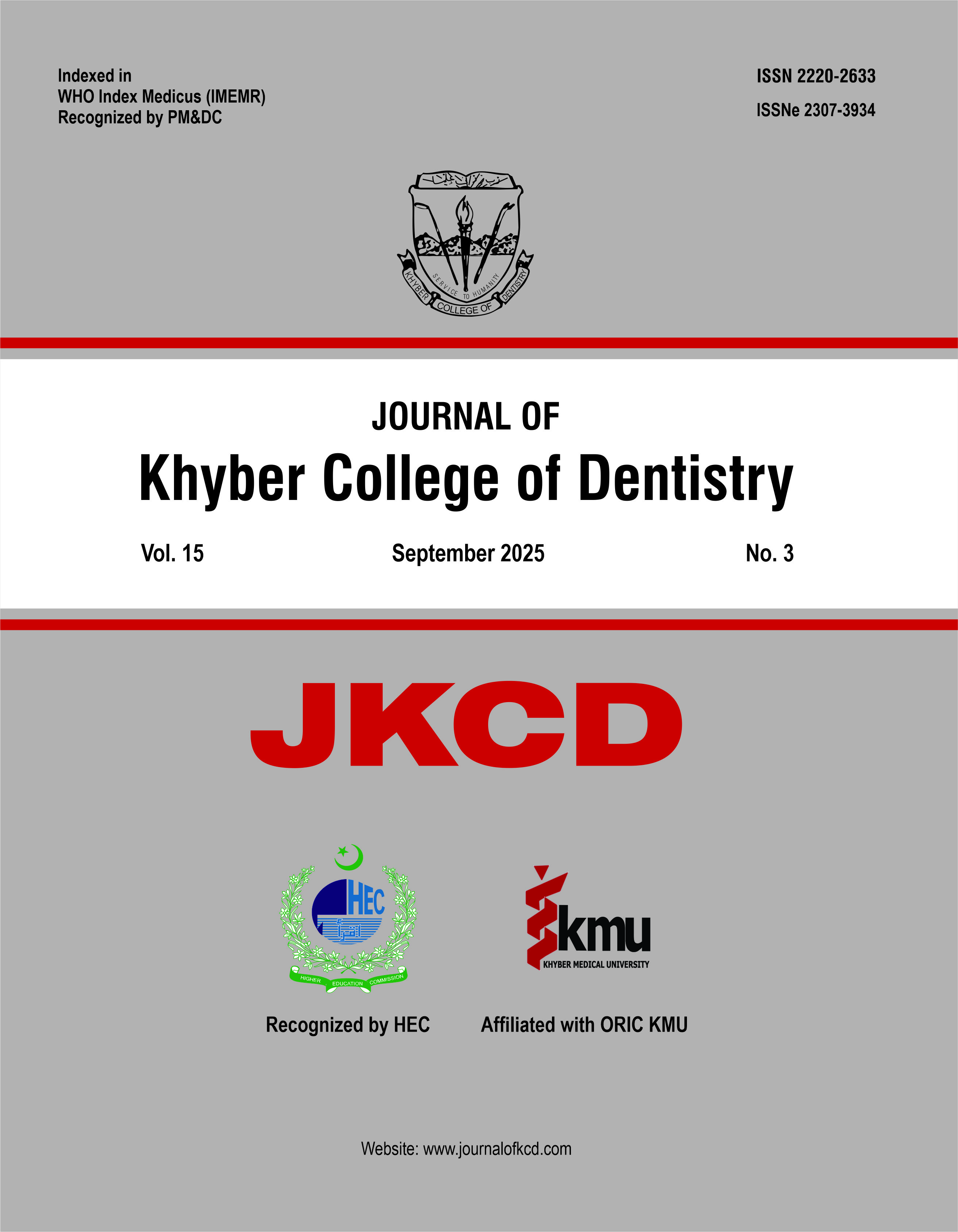AUTOMATED DENTAL FILLING DISPENSING AND POST INSERTION MULTIFOCAL STRESS DISTRIBUTION ANALYSIS FOR IMPROVED TREATMENT OUTCOMES: A PROOF OF CONCEPT
DOI:
https://doi.org/10.33279/jkcd.v15i03.909Keywords:
Dental caries, Automated dental fi lling, Von Mises stress, Simulations, Restorative materialsAbstract
Objectives: The objective of this manuscript was to integrate COMSOL-generated data and use a dental filling robot to fill a wax model of a molar tooth with the recommended filling material.
Materials and Methods: The study was exempt from the ethical review board. It was designed as a proof of concept. Von Mises stress distribution was calculated using COMSOL Multiphysics based on 4 different restorative materials: amalgam, composite, glass-ionomer and gold for a single wax tooth with a deep cavity. The Composite was chosen based on the size of the cavity and stress distribution as the most appropriate material. The restoration was completed using a custom-made robot that deposited composite into cavity
incrementally. UV light was used to set the material.
Results: Composite was selected based on its superior properties in comparison to the other materials; Von Mises stresses 114.85 under a masticatory load of 100 MPa. A servo motor was used to control the composite increment deposition from the reservoir through a piston. Each increment was cured. This motion was repeated until the cavity was adequately filled as identified through the camera.
Conclusion: Light cured composite was the most appropriate filling material selected following simulations generated through COMSOL Multiphysics. Simulations on COMSOL using DICOM images from prepared teeth can be coupled with a filling dispension robot to automate the filling process.
References
Cheng L, Zhang L, Yue L, et al. Expert consensus on dental caries management. Int J Oral Sci. 2022; 14:17.
Peumans M, Politano G, Van Meerbeek B. Eff ective
Protocol for Daily High-quality Direct Posterior Com
posite Restorations. Cavity Preparation and Design. J
Adhes Dent. 2020; 22:581-596.
Ruengrungsom C, Palamara JEA, Burrow MF. Comparison of ART and conventional techniques on clinical performance of glass-ionomer cement restorations in load bearing areas of permanent and primary dentitions: A systematic review. J Dent. 2018; 78:1-21.
Worthington HV, Khangura S, Seal K, et al. Direct composite resin fi llings versus amalgam fi llings for permanent posterior teeth. Cochrane Database Syst Rev. 2021;8: Cd005620.
Induri SNR, Chun YC, Chun JC, et al. Protective Measures against COVID-19: Dental Practice and Infection Control. Healthcare (Basel). 2021;9.
Checchi V, Bellini P, Bencivenni D, Consolo U. COVID-19 Dentistry-Related Aspects: A Literature Overview. Int Dent J. 2021; 71:21-26.
Ahmad P, Alam MK, Aldajani A, et al. Dental Robotics: A Disruptive Technology. Sensors (Basel). 2021;21.
Fan ZJ, Shen JQ, Tang L, Fan QM. Optimization for Tooth Profile of Assembled Cathode Based on Comsol. Advanced Materials Research. 2011;189-193:31663169.
Jakubinek MB, O'Neill C, Felix C, Price RB, White MA. Temperature excursions at the pulp-dentin junction during the curing of light-activated dental restorations. Dent Mater. 2008; 24:1468-1476.
Alho T. Inlay Fixed Partial Denture Framework 3-D Structural Integrity Validation Using COMSOL Multiphysics 3.5a. 2009.
Tiong TJ, Price GJ, Kanagasingam S. A computational simulation study on the acoustic pressure generated by a dental endosonic file: Effects of intensity, file shape and volume. Ultrasonics Sonochemistry. 2014;21:18581865.
Varela AE. Application of the level set method for a cavity-fi lling simulation. 2008:223-227.
Czajkowska A, Rydzkowski T, Królikowski T. Modeling and simulation of composite materials used for permanent dental fillings. Procedia Computer Science. 2022;207:1529-1538.
Merhi N, Mohamad N, HajjMoussa G, et al. An Intelligent Infusion Flow Controlled Syringe Infusion Pump. 2019.
Sadun AS, Jalani J, Sukor JA. A comparative study on the position control method of dc servo motor with position feedback by using arduino. 2016; 11:10954-10958.
Haidar A, Benachaiba C, Zahir M. Software interfacing of servo motor with microcontroller. Journal of Electrical Systems. 2013; 9:84-99.
Babaei B, Cella S, Farrar P, Prentice L, Prusty BG. The influence of dental restoration depth, internal cavity angle, and material properties on biomechanical resistance of a treated molar tooth. J Mech Behav Biomed Mater. 2022; 133:105305.
Pai S, Bhat V, Patil V, Naik N, Awasthi S, Nayak N. Numerical Three-dimensional Finite Element Modeling of Cavity Shape and Optimal Material Selection by Analysis of Stress Distribution on Class V Cavities of Mandibular Premolars. J Int Soc Prev Community Dent.
; 10:279-285.
Ausiello P, Ciaramella S, Garcia-Godoy F, Martorelli M, Sorrentino R, Gloria A. Stress distribution of bulkfill resin composite in class II restorations. Am J Dent. 2017; 30:227-232.
Nor FM, Teh ZS, Kurniawan D. Finite element analysis on mechanical performance of amalgam, gold, and bioglass dental filling materials in molar tooth. Materials Today: Proceedings. 2023.
Borgia E, Baron R, Borgia JL. Quality and Survival of Direct Light-Activated Composite Resin Restorations in Posterior Teeth: A 5- to 20-Year Retrospective Longitudinal Study. J Prosthodont. 2019;28: e195-e203.
Bayne SC, Ferracane JL, Marshall GW, Marshall SJ, van Noort R. The Evolution of Dental Materials over the Past Century: Silver and Gold to Tooth Color and Beyond. J Dent Res. 2019; 98:257-265.
Dias AGA, Magno MB, Delbem ACB, Cunha RF, Maia LC, Pessan JP. Clinical performance of glass ionomer cement and composite resin in Class II restorations in primary teeth: A systematic review and meta-analysis. J Dent. 2018; 73:1-13.
Downloads
Published
How to Cite
Issue
Section
License
Copyright (c) 2025 Khadija Khan, Aqsa Zahoor, Natasha Mohsin Butt, Uzma Hasan, Amber Kiyani, Faisal Amin, Zia Ur Rehman

This work is licensed under a Creative Commons Attribution-NonCommercial 4.0 International License.
You are free to:
- Share — copy and redistribute the material in any medium or format
- Adapt — remix, transform, and build upon the material
- The licensor cannot revoke these freedoms as long as you follow the license terms.
Under the following terms:
- Attribution — You must give appropriate credit , provide a link to the license, and indicate if changes were made . You may do so in any reasonable manner, but not in any way that suggests the licensor endorses you or your use.
- NonCommercial — You may not use the material for commercial purposes .
- No additional restrictions — You may not apply legal terms or technological measures that legally restrict others from doing anything the license permits.










